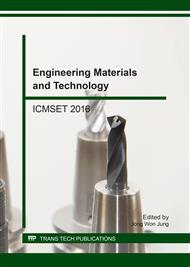[1]
R. K. Chaturvedi, S. Prasad, S. Rana, et al., Effect of dust load on the leaf attributes of the tree species growing along the roadside. Environ. Monit. Assess. 185 (2013) 383-391.
DOI: 10.1007/s10661-012-2560-x
Google Scholar
[2]
L. Lu, G. Dongsheng, M. R. Peart, The morphological structure of leaves and the dust-retaining capability of afforested plants in urban Guangzhou, South China. Environ. Sci. Pollut. Res. 19 (2012) 3340-3449.
DOI: 10.1007/s11356-012-0876-2
Google Scholar
[3]
L. Lu, G. Dongsheng, M. R. Peart, et al., The dust retention capacities of urban vegetation - a case study of Guangzhou, South China. Environ. Sci. Pollut. Res. 20 (2013) 6601-6610.
DOI: 10.1007/s11356-013-1648-3
Google Scholar
[4]
L. K. Kristen, J. Sarah, K. Iyad, et al., Differences in magnitude and spatial distribution of urban forest pollution deposition rates, air pollution emissions, and ambient neighborhood air quality in New York City. Landscape and Urban Planning. 128 (2014).
DOI: 10.1016/j.landurbplan.2014.04.009
Google Scholar
[5]
X. Zhendong, L. Donghong, The impact of root greening on PM2. 5. J. Hebei Forest. Sci. Tech. (2) (2013) 83-85.
Google Scholar
[6]
J. Jing, W. Gang, D. Xilong, et al., Evaluation of adsorbing haze PM2. 5 fine particulate matters with plants in Beijing-Tianjin-Hebei region in China. Scient. Sin. Vitae. 43(8) (2013) 694-699.
DOI: 10.1360/052013-154
Google Scholar
[7]
C. Yixin, Z. Ning, H. Huanjin, Dust removal effect of urban species in Harbin. Chinese J. Appl. Ecol. 13(9) (2002) 1121-1126.
Google Scholar
[8]
L. Haimei, L. Xia, Relationship between leaf epidemal morphology and dust-retaining capability of main garden trees in Chengyang District of Qingdao City. Chinese J. Ecol. 27(10) (2008) 1659-1662.
Google Scholar
[9]
L. Lu, G. Dongsheng, C. Yongqin, Morphological structure of leaves and dust-retaining capability of common street trees in Guangzhou Municipality. Acta. Ecol. Sin. 33(8) (2013) 2604-2614.
DOI: 10.5846/stxb201201100054
Google Scholar
[10]
C. Wei, H. Xingyuan, Z. Ao, et al., Dust absorption effect of urban conifers in Northeast China. Chinese J. Appl. Ecol. 14(12) (2003) 2113-2116.
Google Scholar
[11]
P. K. Rai, L. L. S. Panda, Dust capturing potential and air pollution tolerance index (APTI) of some road side tree vegetation in Aizawl, Mizoram, India: an Indo-Burma hot spot region. Landscape and Urban Planning. 7 (2014) 93-101.
DOI: 10.1007/s11869-013-0217-8
Google Scholar
[12]
W. Huixia, S. Hui, L. Yangyang, Relationships between leaf surface characteristics and dust-capturing capability of urban greening plant species. Chinese J. Appl. Ecol. 21(12) (2010) 3077-3082.
DOI: 10.1109/iswrep.2011.5893701
Google Scholar
[13]
B. Aliya, H. Umut, A. Tayierjiang, et al, Patterns of dust retention by five common tree species for urban greening in Aksu City, Northwest China. Chinese J. Plant Ecol. 38(9) (2014) 970-977.
DOI: 10.3724/sp.j.1258.2014.00091
Google Scholar
[14]
Z. Jing, W. Xiangyun, Detaining dust law of landscape greening plants leaves in urban area of Fuxin. J. Liaoning Technical University (Natural science). 30(6) (2011) 905-908.
Google Scholar
[15]
W. Lei, G. Shangyu, L. Lianyou, et al, Atmospheric particle-retaining capability of eleven garden plant species in Beijing. Chinese J. Appl. Ecol. 17(4) (2006) 597-601.
Google Scholar


